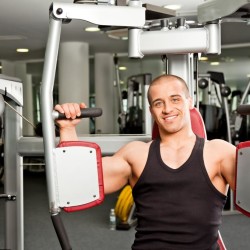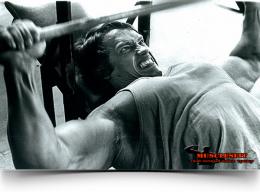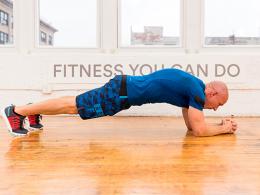Bench press. Complete Guide
The bench press (bench) is a basic free weight exercise. It develops the muscles of the chest, shoulders (anterior bundle of deltoid muscles) and arms (triceps). This is the most effective upper body strength and muscle building exercise because you lift most of the weight above you (more than standing chest presses). The bigger the bench, the bigger your chest.
The correct starting position for starting this exercise is lying on a bench, legs on the floor, resting with the entire foot (shin is perpendicular to the floor). Remove the barbell from the rack with straightened arms. Lower the bar to the middle of your chest. Raise (Push) the bar up until your elbows are straight. Keep your pelvis on the bench. The bench press consists of 5 reps in a 5x5 program (workout A).
how to properly perform the bench press (on the bench): lower the barbell to the middle of the chest. Squeeze (lift) the bar up until you straighten your elbows.
To avoid shoulder pain, keep your elbows at a 75º angle as you lower the barbell. Do not try to stretch your chest by raising your elbows to 90º. You injure your shoulder joint when the base of your forearm is perpendicular to your torso. Spread your elbows (hold your elbows) at a 75º angle to avoid pain.
Unlike the squat or deadlift exercise, the bar does not move in a vertical plane when you perform the bench press correctly. It moves diagonally to the middle of the chest above the shoulders. Thanks to this, you can avoid injury to the shoulder joint. This is the most efficient way to bench press with heavy weights.

lie down on the bench, take the barbell, remove it from the rack, lower the barbell to the middle of the chest, lift it back.
Perform the bench press on a special machine (power rack) for maximum safety. Set the restraints at a comfortable height so that they can hold the weight if you can't lift it. You do not need an assistant if you are doing the exercise on the same machine as me. If you do not have a special rack (power rack), ask someone in the gym to insure you during this exercise. Follow these 5 easy steps to properly bench press.
- Training. Lie down on the bench so that your eyes are under the bar. Raise your chest and pull your shoulder blades together. Leg with the whole foot rests on the floor
- grip. Place your little finger on the indicated (ring) places. Hold the barbell at the base of your hand, fully grasping it without bending your wrists
- lifting the bar. Take a deep breath and grab the bar with straight arms. Carry the bar over your shoulders without bending your elbows.
- Lowering the boom. Lower the bar to the middle of your chest, keeping your elbows at a 75º angle to your torso. After lowering the bar, take a short pause.
- Lifting the bar. Squeeze the bar from the middle of the chest to its original position (above the shoulders). Keep your pelvis on the bench. Straighten your elbows. Take a breath.
Set the barbell on the rack after doing the 5x5 exercise for power lifts. On the final rep, lift the weight from your chest until your elbows are straight. Then, install the barbell on the power rack. As soon as you touch the bar, bend your elbows to lower the bar onto the holders.
Preparing to perform the bench press (on the bench)

How to prepare for the bench press exercise (on a bench): sit on a bench, lie down, bring your shoulder blades together, grab a barbell, put your legs in the correct position.
Before doing the exercise, set up the necessary equipment. Set the rails to a suitable height so that they catch the weight if it falls. Sit strictly in the center of the bench. Get into the correct starting position before you remove the weight (start the exercise). Your wrist will bend if you grab the bar incorrectly. Your shoulders will begin to move if your shoulder blades aren't pulled together tightly. You will not be able to correct their position in the middle of the exercise, and this may cause the weight to fall on you. Compliance with these rules (recommendations) will contribute to the successful completion of the exercise and the development of chest muscles.
- Lying position(on the bench). To begin, sit on the edge of a flat bench. Lie down with your back flat on the bench. Lie down so that the bar is at eye level.
- Flattening of the shoulder blades. push your chest forward, tighten your upper back, bring your shoulder blades together as much as possible and lower them down.
- grip. The little finger is on the inside of the ring marks. Firmly grip the barbell with a brush so that he cannot change position.
- Leg position. legs stand straight (flat with the whole foot) on the floor, under the knee there should be an angle of 90º with respect to the floor.
- Removing the bar. With straight hands, remove the barbell from the holders. Bring the barbell up to shoulder level. Ready.
Do this prep before every bench press. Thorough and consistent preparation for the exercise will help you successfully cope with weight. By developing the technique of execution, you increase the effectiveness of the exercise. When preparing, pay attention to the weight with which you will work. Follow the rules when preparing for a warm-up or doing basic strength exercises.
Bench press 101

The effectiveness of the bench press depends on your physique. The wider your shoulders, the wider your grip should be. The longer your forearms, the closer your elbows will be to your torso in the down position. Do not try to repeat the technique of this exercise after another person until you have a similar physique. Instead, stick to the basic rules for doing the bench press; As you gain experience, you will improve your form.
- grip. Hold the bar firmly at the base of your palm.
- width grip. palms are within (inside) the circular marks. When lowering the bar, the forearms should be vertical.
- Big finger arms. The thumb should wrap around the bar.
- brushes. The hands should be straight from the bar to the elbow. Do not bend your hands - this can hurt.
- Elbows. In the lower position, the elbows should be at an angle of 75º with respect to the body. They should not touch the body or move apart ("fly apart") at an angle of 90º.
- forearms. Should be vertical to the floor.
- Shoulders. Keep your shoulders off the bench. Do not push your shoulders forward when the bar is in the top position.
- Upper part back. Squeeze your shoulder blades together for maximum stability while pressing.
- Breast. lift your chest up to the ceiling. The bar should touch the chest when in the down position.
- Head. in the prone position, the bar should be at eye level.
- Small of the back. A natural curve that allows you to move your hand freely between the bench and your back.
- Taz. Keep your pelvis on the bench. Do not try to cheat by lifting the pelvis from the bench.
- Feet. They are flat on the floor, strictly on the knees, at an angle of 90º, shoulder width apart.
- Withdrawal rods. Remove the barbell (with weight) from the holders by straightening your elbows. Pass the barbell over your shoulder joints.
- lowering rods. Lower the bar to the middle of your chest. Spread your elbows at a 75º angle in the bottom position.
- Down position. The brushes are straightened, the brushes are vertical. The elbows are turned towards the body, not away from it.
- Lifting the bar. Do not pause in the down position. Squeeze the bar to the top position (above the shoulders). Lock your elbows up.
- Fixation of the bar in the upper position (“lockout”). Lock the bar in position above the shoulder joint. Lock your elbows in the up position. Do not rush to bend your elbows back.
- Return of the bar to the holders. On straight elbows, bring the bar to the rack, slowly lower it to the holders.
- The trajectory of the rod. Diagonal line from the middle of the chest to the position above the shoulders. Wrong - a straight vertical line over the shoulders, neck or chest.
- Breath. Take a deep breath in the top position, hold your breath while lowering the bar and in the bottom position. Exhale in the up position.
Safety

How to urgently finish the bench press: lower the bar to the middle of the chest, make the chest flat (exhale), so that the bar touches the holders (frame). Crawl out from under the bar.
You will never get stuck under a weighted bar if you bench press inside a power rack. The power rack has horizontal holders that can pick up the weight in the event of an unsuccessful barbell lift. Set the horizontal holders slightly below the extreme drop point of the boom. With a successful repetition, the holders will not interfere with you. If you fail to lift the weight. In this case - lower the weight to the middle of the chest, flatten the chest (exhale) to lower the barbell onto the holders (frame). The bench press in a power rack is the safest way to perform this exercise.
It is dangerous to perform the bench press without a power rack or an assistant. If you are crushed (stuck under) the bar, then the only way to get out from under it is the "Shame Roll". Lower the bar to the middle of your chest, “roll” it to your stomach, then lift the body and lift the weight (the article says - do a deadlift). This will not be very pleasant and may leave bruises on the abdomen. An alternative way is to do the bench press without weight clamps, in which case you can tilt the bar to one side and dump some of the weight (pancakes) on the floor, however, by doing so you will violate the rules of conduct in the gym by roughly dropping the weight on the floor.
The dumbbell bench press looks safer, but it's not. Although it should be noted that you will never get stuck under the weight. But if you fail to lift heavy dumbbells, they can fall on your face and seriously injure you, or you can throw dumbbells on the floor, which also does not please the general manager. The bench press in a power rack is the safest way to do this exercise because the horizontal holders can pick up the weight if you fail to lift it (if you get stuck under it). The power rack will also prevent the barbell and plates from falling to the floor. But even a power rack won't help if you can't handle the weight of the dumbbells.
The fear of hurting yourself while doing the bench press is normal. People die from accidents under the barbell. To avoid this, always hold the bar with a full grip (the thumb should be opposed to the others), this will eliminate the possibility of the bar rolling and falling on the chest. Don't do heavy bench presses without a power rack. Start with light weights, focus on the technique of the exercise, and only then, gradually increase the weight. Following safety rules will give you confidence and you will overcome fear. Don't forget to set up horizontal holders, even if you think you can handle the weight.
Bench Press Technique
Grip technique

left: grip in the middle of the palm - the hand will bend and hurt. In the middle - grip with the lower part of the palm, the brush will not bend. On the right - green indicates the correct position of the barbell in the palm of your hand.
Full grip. The thumb wraps around the bar. This is the safest and most effective way to hold the barbell. Pinch the bar so that it cannot move during the exercise. The muscles in the arms, shoulders, and chest will have a harder time contracting, which will increase the load during the exercise (hyperload). Do not relax your arms (palms) during the bench press. Hold the barbell as tightly as possible.
Wrong grip. the thumb should be opposed to the other four, which creates a lock that prevents the bar from rolling and falling onto the chest. If the bar slips out of your hand and no assistant has time to help you, the bar may fall on your chest, throat or face. This can lead to an accident or death. If your hand (wrist) hurts, take the barbell closer to the base of the palm, this position will not allow your hand to bend.
Bulldog grip. The easiest way to properly grab the barbell is to use a bulldog grip. Grabbing the barbell, twist your palm around it to get a better grip on the bar. Hold your palm firmly so that the barbell cannot move. This grip will keep the bar from slipping out of your hands. Try this grip variation for a few workouts and you'll get used to it.
Grip Width

Left: Grip too wide, forearms angled. Middle: The grip is too narrow, accentuating the triceps. Right: The most efficient way to bench press.
Medium grip. Take the barbell so that the little fingers are inside the designated area. forearms should be vertical when lowering the barbell. Your body type determines the width of your grip. A narrower grip is not effective for developing the pectoral muscles in the way that it involves the muscles of the arms, focusing on the triceps.
Vertical forearms. Your forearms should be vertical, in other words, perpendicular to the floor. If your elbows are on the outside of your hands when lowering, it's harder for you to lift the weight (you're also using your triceps). If your elbows are inside your hands, you are loading your shoulder joint. Keeping your forearms vertical as you lower the bar helps determine the correct (suitable) grip width.
brushes

Straight brushes. Straight wrists are the safest and safest way to bench press (straight vertical line - barbell, wrist, elbow when the bar is in the down position). Remember, if you bench press with bent hands, they will hurt. Sports tourniquet (special bandage) - will not help solve this problem. Straighten your wrist with the barbell positioned correctly in your hand (closer to the base of your palm).
Grab with the bottom of the hand. Do not hold the bar in the middle of the palm or close to the fingers as in the deadlift. Gravity will pull the bar down and this will cause your hands to bend and hurt, to avoid this hold the bar close to the base of your palm. In preparation for the exercise, take the barbell with a bulldog grip, twist your palm to grab the barbell tighter.
Elbows
Spreading the elbows when lowering the bar can lead to sharp pain in the shoulder (shoulder impingement syndrome). , the syndrome is based on mechanical impact of the tendons of the muscles of the rotator cuff and the anteroinferior part of the acromion, especially when the shoulder bent forward turns inward)

Elbow grouping(correct position of the elbow joint). While lowering the bar, you need to bring your elbows together a little. Your physique will determine how much you need to bring your elbows together (the optimal angle at which you should keep your elbows in relation to the body is 75º). Your shoulders (anatomical) should not be strictly perpendicular to your torso when the bar is in the down position. It is also necessary to remember that excessive reduction of the elbows (to touch with the body) will adversely affect the effectiveness of the bench press. Remember that the safest and most effective way to perform this exercise is to keep your forearms strictly vertical (perpendicular to the floor) in the down position.
Don't touch your body. When the elbows touch the torso, they are “inside” (in relation to the hands). The weight will be harder to lift and it will put extra stress on the joints. Professional powerlifters wear compression shirts. But we do not use such T-shirts, so our hands and elbows must be in the same vertical line so that the bench press is as effective as possible. Do not spread your elbows to the sides when the bar is in the down position.
Don't disclose(do not arrange) elbows. We advise you not to lower the bar if your elbows are more than 90º apart. We also don't advise you to do a bodybuilder-style bench press with your elbows perpendicular to your torso in the low position. You injure your shoulder joint in an attempt to stretch your chest muscles more. The upper arm will "hit" the rotator cuff against the acromioclavicular joint on each rep. The shoulder joint will become inflamed and sore. In the lower position, keep your elbows at a 75º angle to your torso.
Spread your elbows during only lifting the weight. Lifting the weight should mirror the trajectory of lowering the bar. You must spread your elbows while lifting the weight and bring the barbell to a position above your shoulders. Otherwise, you will be lifting the bar just above your chest. This lifting trajectory is considered ineffective when working with heavy weights. “Push” the weight from the middle of the chest to a position above the shoulders, spreading the elbows.
Vertical (perpendicular) forearms. The most effective way to bench press is to keep your forearms perpendicular to the floor when the bar touches your chest. A straight perpendicular line from the hand to the elbow will create effective leverage for working with heavy weights without pain in the hands. If your elbows are too close or too far - intercept the bar (the bar should be held at the base of the palm, bulldog grip) and change the grip width.
Fixation of the rod in the upper position. Return the barbell to the machine with your elbows straight. Straighten and lock this position every time you lift the bar. The bench press is not performed correctly if you do not straighten your elbows in the upper position, because: firstly, the repetition will not be counted; secondly, you can drop the barbell and injure yourself; thirdly, it is safe to fix the elbows in a straightened position with a full range of motion.
forearms

Left: Vertical forearms with a bar on the shoulders, causing injury. Two in the middle: forearms not vertical, touching chest too high/low. Right: vertical forearms, the most effective way.
When viewed from the side (side) the forearms should be vertical (parallel and perpendicular to the floor). Your forearms should be vertical (parallel and perpendicular to the floor) when the bar touches your chest. A strict vertical line should be visible from the side - a barbell, a brush, an elbow. This is the safest and most effective way to bench press. If your hands are bent (backward), grab the bar with a bulldog grip. Make sure that the elbows are in the correct position (at an angle of 75º in relation to the body). Lower the bar to the middle of your chest.
Vertical front. Your forearms should be vertical (parallel and perpendicular to the floor) on either side (front or back). Tilt the forearms is not recommended. this will negatively affect the effectiveness of this exercise. The close grip bench press will engage the triceps more. If you bench press with too wide a grip, it will cause problems for the shoulders (shoulder injury).
Head position

Eyes under the bar. Lie down on the bench so that your eyes are under the bar. This position minimizes the distance between the power plant and the shoulders. Do not lie down far from the holders - it will be inconvenient for you to remove and return the barbell to its place, it will require a lot of strength from you, and it will also be unsafe. Therefore, the bar should be above your eyes when you lie on the bench and look straight at the ceiling. If during the lifting of the bar you touch the racks, you are lying too close.
Do not rest (do not press) your head on the bench. Your neck will hurt if you push your head against the bench during the bench press. Tighten your neck muscles without putting pressure on the bench. The easiest way to avoid this is to keep your head off the bench. The muscles will be tense if the head does not touch the bench. Your neck won't get hurt because you'll be pushing it into the bench.
Keep your head in a neutral position (flat). Do not turn your head to look at the racks or you will injure your neck. Keep your head down to check if the bar is touching your chest. Keep your head straight (in a neutral position), eyes looking at the ceiling. At the end of the approach, fix the bar over your shoulders, return the bar to the power plant. When you return the barbell to the holders, bend your elbows and lower your arms.
Shoulders
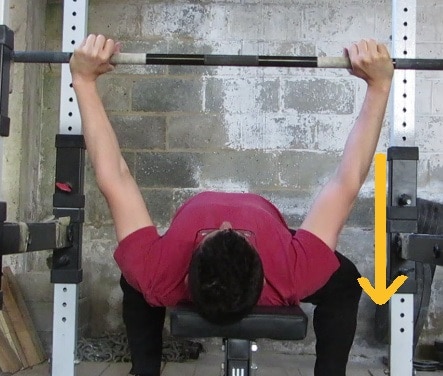 Shoulders should be kept on the bench. Keep your shoulders on the bench. Do not stick them forward during the bench press. If your shoulders are pulled forward, your arms will be higher than they should be. Therefore, it will be much more difficult for you to perform this exercise. In preparation for the bench press, lie down so that your shoulders are on the bench.
Shoulders should be kept on the bench. Keep your shoulders on the bench. Do not stick them forward during the bench press. If your shoulders are pulled forward, your arms will be higher than they should be. Therefore, it will be much more difficult for you to perform this exercise. In preparation for the bench press, lie down so that your shoulders are on the bench.
Don't push, push. The best way to keep your shoulders on the bench is to imagine that you need to push the barbell away from you (from your chest). Imagine what you are doing and pushing off the floor.
ask someone to help you. Your shoulders may move forward when you remove the barbell from the holders. Some power racks have enough markings for the holes, so the racks may be too high or low. When the holders on the stand are too low, this can cause strain in the hands. If the racks are too high, you will have to lift your shoulders off the bench to reach and put the bar back in place. To avoid these situations, ask someone to help you.
Upper back

Squeeze your shoulder blades together as if you were trying to hold a handle between them. This will give you the best bench press position.
bring your shoulder blades together. Keep your upper back toned (do not relax) while doing the bench press. Imagine that you have a pen between your shoulder blades and you need to hold it. This will even out (flatten out) your upper back and increase stability when you lie down on the bench. You can press the top of your back into the bench, this will increase the effectiveness of the exercise. Be sure to pull your shoulder blades together before removing the barbell from the rack.
Stay tuned (don't relax). do not stick your shoulders forward (up). You will lose tension in your upper back, your chest muscles will weaken, and your arms will rise higher than they should - you will be hard. Keep your upper back in good shape, pull your chest forward and your shoulders back. Do not lose tension even when you are helped to remove the weight or return it to the rack. Remember to press your upper back into the bench on each rep.
Breast

Raise your chest towards the ceiling as you press. Notice my T-shirt is tighter on the right. My chest is fuller. This is a more efficient way to bench press.
Raise your chest. In preparation for the exercise, bring the shoulder blades together. Raise your chest. Do this by arching your lower back (lower back) and turning your chest up. Keep your pelvis on the bench. Squeeze (tighten) the latissimus dorsi muscles to fix the correct position. This position reduces the stroke of the rod, reduces the movement of the rod in the horizontal plane.
The chest should not remain flat. With a flat chest bench press, you are forcing the bar to touch your chest at a very low point. The farther the bar is from your shoulders, the harder it is to lift it. If your chest is flat, you risk dislocating your shoulder joints and injuring them. You "do not deceive" the range of motion by pushing the chest forward, on the contrary, you do the exercise more efficiently and safely.
Lower Back
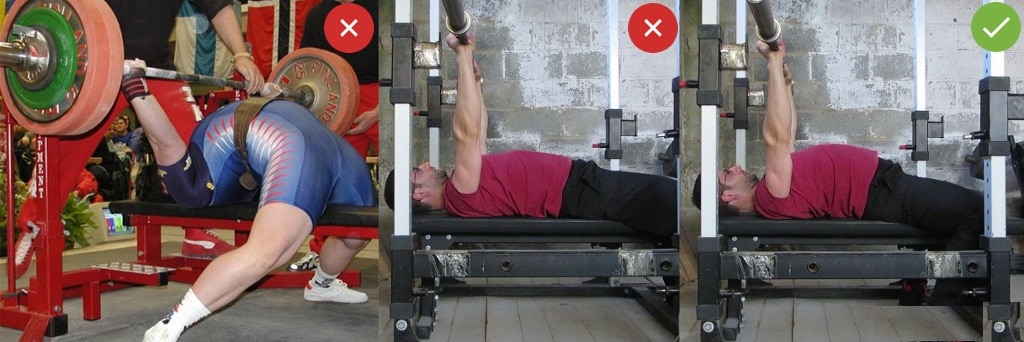
Deflection in the lower back. Do a bench press with a back arch. Lie down on the bench so that there is a natural deflection in the lower back. Your palm should pass freely between the lower back and the bench. The curve will help you lift your chest. It will increase the effectiveness of this exercise. When making a deflection in the lower back, do not forget to keep the pelvis strictly on the bench.
Don't kink. The bend in the lower back should not resemble a horseshoe. And yet, some athletes will bend too much to handle more weight. We do not recommend that you do this - as it injures the spinal discs. Some people think that excessive arching in the lower back is a "scam" because. this reduces the distance of movement of the bar. Remember that the curve in the lower back should be natural.
You can not do the bench press with a flat and even back. Our goal is to bench press with the chest up. This position is safer for the shoulders and helps with heavy weights. A flat back will not allow the chest to rise up and bring the shoulder blades together. Maintain a natural arch in your lower back to tone up (keep your muscles tight). excessive deflection can lead to pain.
Taz

Don't lift your ass off the bench.
The pelvis should always be on the bench. During the bench press, keep your pelvis on the bench. Your lower back may be lifted off the bench, but not your pelvis, otherwise the rep will not count. During the bench press, the legs should rest on the floor, and the top of the back and buttocks on the bench.
Never lift your pelvis off the bench. Lifting the pelvis off the bench is cheating. This simplifies the press by reducing the trajectory of the bar. During a pelvic lift competition, you receive 3 red signals. In addition, you risk injuring the lumbar if you arch your back too much. If you tear your pelvis off while doing a bench press, this repetition does not count.
Legs

Keep your feet on the floor. Don't put your feet on the bench or lift them up during the bench press. This puts you in an unsteady position and is ineffective when lifting large weights. you cannot use the foothold. The position of the feet on the floor increases your stability, balance and strength. This will help you maintain the correct position of the chest (up) and the natural deflection in the lower back.
Heels on the floor. Do the bench press only when the entire foot rests on the floor. Do not lift your heels off the floor as this reduces your stability. The larger the area of support, the better you keep your balance during the exercise. Some lifters do the bench press with their heels up, but the World Bodybuilding Organization doesn't allow it.
Barbell squat. During the bench press, the feet (heels) should be shoulder-width apart. Use the same position when doing barbell squats. Do not bench press if your feet are narrower than shoulder width, this position is less stable. If your hips hurt or cramp, your feet (legs) are too wide apart. Place your feet already, shoulder-width apart. Rotate your feet 30º so they are in line with your hips.
Knees over ankles. This means that your knees are bent at a 90º angle with your lower leg upright. Don't bench press if your ankles are in front of your knees, as this prevents you from pushing off the floor and reduces your strength. The ankles can be slightly out of the knees, as long as you don't lift your heels off the floor or over-bend your lower back.
Lockout ( straightening arms with a projectile on the racks )

Bar above the shoulders. The barbell is in a balanced position when you hold it over your shoulders. Holding the bar above the chest is more difficult - it's like. Test (check it yourself): fix the barbell without weight on outstretched arms above the shoulders. Move it to a position over the chest, then over the face, then back over the shoulders. You will notice that the latter is the easiest to hold the bar because it is the point of balance. Remember to straighten your elbows after each rep.
Fix the position of the elbows. End each rep by locking your elbows. Do not leave them in a bent position to further load the muscles. You can fail and drop the barbell on your face and die. Lock your elbows in a straight position so that your skeleton, not your muscles, supports the weight. Take care of your elbows - don't overload them.
Rod trajectory

Diagonal line. The correct trajectory of the movement of the bar during the bench press is a diagonal line from the position above the shoulders to the middle of the chest and back. This trajectory is longer than a straight line (from the middle of the chest straight up), but it protects the shoulders from injury to the shoulder. The elbows should be spaced at an angle of 75 with respect to the torso in the lower position, in order to allow mechanical impact of the tendons of the rotator cuff muscles and in front of the lower part of the acromion. The bar should be fixed on straightened arms in a position above the shoulders (at the points of balance). To do this, you need exactly the diagonal trajectory.
Not a vertical path. Unlike the squat and deadlift, the vertical trajectory of the bar does not work and is not welcome in the bench press. If you lift the bar straight up, it forces your elbows to 90. This injures your shoulders and makes the exercise more difficult. The safest and most effective way to bench press is to follow a diagonal path over your shoulders to mid-chest and back.
Raise your chest. The trajectory of the movement of the bar cannot be vertical during the bench press. Otherwise, you spread your elbows wide and lift the bar strictly above your chest. This is not safe for your shoulders and is ineffective. Press the bar from your chest in a diagonal path, then make the path more vertical by lifting your chest. Lower the bar to the middle of your chest (chest up). Keep your pelvis on the bench.
Breath
Inhale. Remove the barbell from the rack while holding it over your shoulders. Inhale, hold your breath and lower the barbell. Inhaling will help you keep your muscles toned (tensed). it will also help you keep your chest up, your shoulder blades together, and your lower back arched. Don't inhale (breathe) when lowering the barbell, the muscles won't be tense (you won't be toned).
Hold your breath in the lower position. Do not exhale when the bar is in the down position. Your chest will deflate like a balloon, you will lose tone and it will be very difficult for you to lift weight. Hold your breath as you lower the bar down. Your blood pressure will rise, but it will return to normal when the exercise is over. And the muscles trained by the bench press will help lower blood pressure because there will be less load on the heart (literal translation - I strongly doubt the reliability of the information).
Exhalation. Exhale as you lock the weight on straightened elbows above the shoulders. But do not exhale completely between repetitions - you will lose muscle tone. Experienced athletes do several repetitions on one breath. inhale deeply before doing the first rep. Breathe not deeply between repetitions so as not to lose muscle tone. You can exhale slowly through the glottis (anatomical) while lifting the bar, provided your pressure is too high.
Possible Bench Press Variations
narrow grip
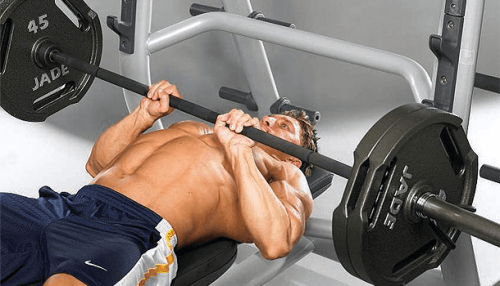 Bench press with a narrow grip. Set up the bench the same way you would for a regular bench press. Lie down on a bench. Raise your hands up. Take the barbell with a narrow grip (hands shoulder-width apart). In the upper position, the hands should be above the shoulders, and in the lower position, next to the body. The same grip you use with the overhead press. Lower the bar to the middle of your chest and press it back.
Bench press with a narrow grip. Set up the bench the same way you would for a regular bench press. Lie down on a bench. Raise your hands up. Take the barbell with a narrow grip (hands shoulder-width apart). In the upper position, the hands should be above the shoulders, and in the lower position, next to the body. The same grip you use with the overhead press. Lower the bar to the middle of your chest and press it back.
Bench press with a narrow grip is more difficult to do than with a medium grip. The trajectory of the movement of the bar is longer because in the top position your arms are vertical. This exercise is for the development of the triceps, so the pectoral muscles work less. When using the same muscles, the close grip bench press loads the chest muscles by 20% less.
The close grip bench press is a good complementary exercise. A narrow grip keeps the elbows close to the body. If your shoulders hurt when doing the bench press correctly, change the grip to a narrower one. Many people who suffer from shoulder pain with a medium grip can perform bench presses with a narrow grip painlessly. You'll be lifting less weight, but it's better than no bench press at all.
Just do not take the barbell with a too narrow grip. Your hands should not touch each other. In this case, your hands are too far from the forearms - the hands will hurt, and the barbell will be difficult to keep in balance. With a narrow grip, your hands should be about shoulder width apart.
Incline Bench Press
 The incline bench press is done on an incline bench. Set the bench at an incline of 45. Lie on the bench, resting your feet on the floor, take the barbell with a medium grip. Remove the bar with straight arms, lower it to your upper chest, and then lift it to a position above your shoulders. Do not lift your pelvis off the bench, maintaining a natural arch in your back. We recommend doing this type of bench press in a power rack to avoid injury if you can't handle the weight.
The incline bench press is done on an incline bench. Set the bench at an incline of 45. Lie on the bench, resting your feet on the floor, take the barbell with a medium grip. Remove the bar with straight arms, lower it to your upper chest, and then lift it to a position above your shoulders. Do not lift your pelvis off the bench, maintaining a natural arch in your back. We recommend doing this type of bench press in a power rack to avoid injury if you can't handle the weight.
Many do this exercise to pump up the upper chest. But you can't isolate any specific part of the muscle. The pectoral muscle is a biceps muscle, one part of which is attached to the collarbone, and the other to the ribs. They always work together no matter what bench you do, you can't isolate one of them.
The best way to build (pump up) your upper chest is to do (improve) the bench press and the overhead press. The bench press engages all the pectoral muscles, while the overhead press puts more emphasis on the upper chest, because it is somewhat similar to the bent over press. The stronger your pec (pectoral) muscle, the bigger it gets.
It also promotes the development of external and internal chest muscles. The small pectoral muscles are located under the main pectoral muscles, so they are not visible. The main muscles you work with are the main pecs. And the best way to pump them up is to perfect the bench press.
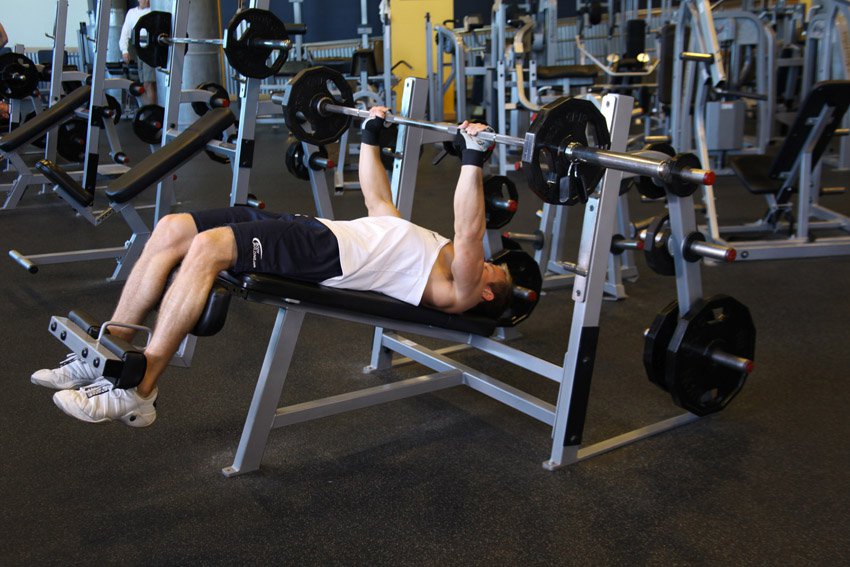 Set up the bench so that your hips are above your head. You need a bench with a reverse incline and a leg lock so that you do not slip into them during the exercise. Lie down on a bench, grab a barbell, lower it to your chest, and then push it up. We recommend doing this variation of the bench press with a helper who can pick up the weight if the repetition fails. Many people do the reverse incline bench press to work their lower chest.
Set up the bench so that your hips are above your head. You need a bench with a reverse incline and a leg lock so that you do not slip into them during the exercise. Lie down on a bench, grab a barbell, lower it to your chest, and then push it up. We recommend doing this variation of the bench press with a helper who can pick up the weight if the repetition fails. Many people do the reverse incline bench press to work their lower chest.
Reverse Bench Press is a waste of time. You will not be able to isolate the lower chest because the chest muscles act as one. It's like doing a half squat. Just improve your bench press and your lower chest will grow.
Be sure to read about it
